THE FIRST
METHODIST EPISCOPAL CHURCH
MUSCATINE, IOWA
Source: FamilySearch.org, film #008530981
Transcribed by A Volunteer, May 10, 2023
Image 634
Charter Members of the First Methodist Church, Muscatine.
| George Bumgardner | | John A. Parvin |
| Sarah Bumgardner | | Hannah D. Parvin |
| Sarah Morford | | Mary Williams |
| Thomas Morford | | |
Pastors Serving the First Methodist Church, Muscatine:
| 1839-40 Rev. Mr. Brace | | 1867-70 W. F. Cowles |
| 1840-41 Nathan Jewett | | 1870-73 J. B. Blakeney |
| 1841-42 Joseph Kirkpatrick | | 1873-76 J. W. McDonald |
| 1842-43 James L. Thompson | | 1876-78 G. N. Power |
| 1843-44 E. S. Norris | | 1878-80 D. Murphy |
| 1844-45 Elisha S. Norris | | 1880-83 John Haynes |
| 1845-46 D. Worthington | | 1883-86 H. E. Wing |
| 1846-47 J. B. Hardy | | 1886-91 W. G. Wilson |
| 1847-49 John Harris | | 1891-96 J. F. Robertson |
| 1849-50 L. B. Dennis | | 1896-99 J. W. Hackley |
| 1850-51 W. Hulburt | | 1899-04 C. L. Stafford |
| 1851-52 Henry Clay Dean | | 1904-06 J. W. Potter |
| 1852-53 Joseph Brooks | | 1906-07 W. P. Stoddard |
| 1853-55 J. H. White | | 1907-08 J. C. Willits |
| 1855-56 John Harris | | 1908-10 Thomas Osborn |
| 1856-57 John W. Sullivan | | 1910-14 L. M. Grigsby |
| 1857-58 John Harris | | 1914-19 U. S. Smith |
| 1858-60 D. Worthington | | 1919-25 George Blagg |
| 1860-62 F. W. Evans | | 1925-29 E. A. Bentzinger |
| 1862-64 John H. Power | | 1929-35 Benj. F. Schwartz |
| 1864-65 W. P. Watkins | | 1933-35 W. H. Schwiering, Associate Pastor |
| 1865-67 G. N. Power | | 1935 LeRoy L. Weis. |
Image 635

The first Methodist Episcopal Church erected in Muscatine, Iowa
in 1851. Corner Sycamore and Third Sts. |

The second building erected in Muscatine by the Frist Methodist Episcopal Church. Dedicted in 1869. Corner Iowa Ave. and Third St. |
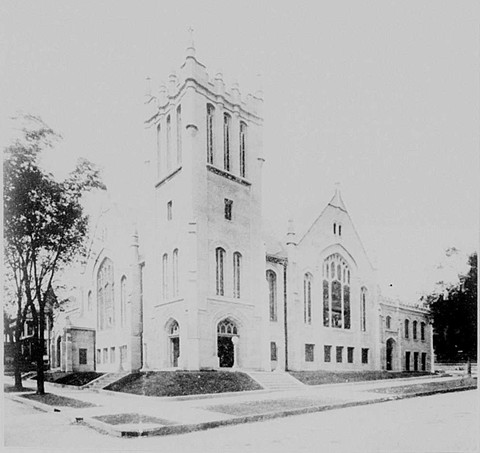
The New Home of the First Methodist Episcopal Church of Muscatine. Located on the corner of Iowa Ave. and Fourth St. |
Image 636 - Basement Plan and Main Floor Plan
Image 637 - Gallery Plan

Rev. Charles Bayard Mitchell, D.D., L. L. D.
Pastor of St. James Methodist Episcopal Church, Chicago
The Dedication Preacher |
Image 638

Rev. L. M. Grigsby, D. D., Pastor
Under whose leadership the Church was built. | 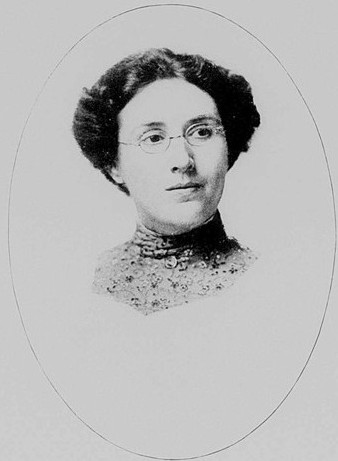
Mrs. L. M. Grigsby |
Image 639

Rev. F. A. Schell., PH. D., D. D.
President Iowa Wesleyan University
Assistant in Dedicatory Services | 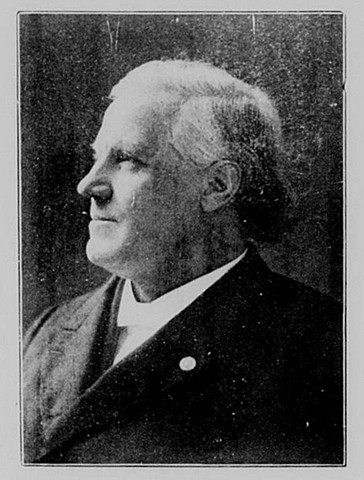
Rev. T. C. Iliff
Preacher for Jubilee Sunday |
Image 640
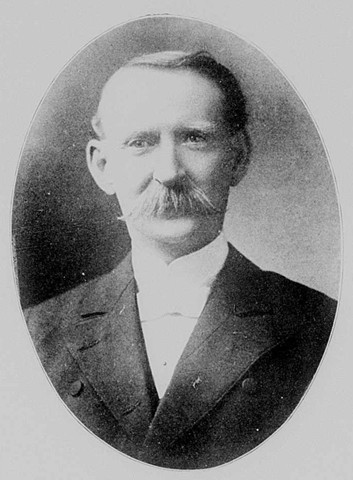
Rev. J A. Boatman, D. D.
District Superintendent | 
Rev. Rev. I. M. Woolverton
Superintendent Wisconsin Conference |
Image 641
Building and Finance Committee

J. B. Hunt, E. O. Burnside,
J. H. Kendig, W. F., Downer,
S. L. Johnson, Clinton Bear | 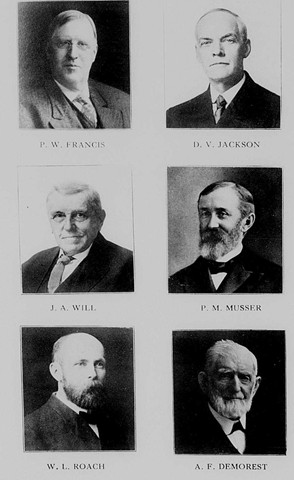
P. W. Francis, D. V. Jackson,
J. A. Will, P. M. Musser,
W. L. Roach, A. F. Demorest |
Image 642
Historical Sketch
(Prepared by D. V. Jackson)
It is a noteworthy fact that in the settlement of the vast territory comprising the States of the Middle West, Methodism has almost universally made the first organized efforts to minister to the spiritual needs of the people, and provide for the sturdy pioneer, beset by the trials and temptations of frontier life, the means and opportunity to meet with his fellows for the orderly and regular worship of God.
That this was so in our vicinity is well established by such records of early days as are still accessible. The town of Bloomington, which afterwards became the City of Muscatine by change of name, was incorporated in 1839, and in May of that year Rev. Brace, a missionary sent out by the Rock River (Illinois) Conference of the Methodist Episcopal Church organized a Methodist class in the new settlement. A list of the members of this class has been preserved and appears elsewhere in this pamphlet.
The first Quarterly meeting of this charge was held in Bloomington, October 3, 1840. The prospect for the immediate evangelization of the little community of less than 200 souls did not appear bright, as is shown by the following extract from the minutes of the recording steward. "Here in the ends of the earth the citizens are much addicted to Sabbath breaking, grog drinking, gambling and swearing. O Thou who holdest the destiny of nations in thy hand, send Salvation to Bloomington."
That this fervent appeal did not go entirely unanswered is abundantly proven by an entry in the record of this same steward dated Nov. 23, 1843, in these words, "The Lord has mercifully visited Bloomington with the out pouring of His Holy Spirit: about fifty have joined the church."
Prior to 1844 a Sunday School was maintained by a union of several denominations, but in that year the Methodists established a Sunday School of their own, Judge Joseph Williams, a distinguished resident of that period, being the first Superintendent. Mr. John Mahin, for many years editor of the Muscatine Journal, and now living in Evanston, Ill., was a member of this school and until his removal from the city in 1903, continued to be prominently identified with it either as scholar, teacher or superintendent.
In the seventy-three years of its history the First Methodist Episcopal Church of this city has had four homes. The first was in a one story frame building which stood on lowa Ave., between Second and Third Streets at the present location of the Journal office. This building was known as the Education Society building and was for a number of years occupied by both the Methodist and Presbyterian Societies interchangeably. Later it was sold at Sheriff's sale and donated to the Methodists by the purchaser, Judge S. C. Hastings.
Sunday, Aug. 17, 1851, saw the dedication of a fine two story brick church building, erected on the corner of Sycamore and Third streets, having a large auditorium on the second floor seating four hundred or more, and a commodious Sunday School room below. This edifice, which for almost twenty years, met the requirements of the congregation and whose walls choed to the eloquent appeals of the sainted Bishop Simpson, the eccentric but brilliant Henry Clay Dean, the fiery though diminutive Frank Evans and many other divines of power and learning, still stands, being used as the seat of our municipal government, otherwise known as the City Hall. The old time customs prevailed in its use and arrangement as a house of worship or "meeting house". The men all sat on one side and the women on the other while the boys and younger generation were relegated to the stove in the rear or the gallery above where they could be under the watchful eye of the sexton. No musical instrument was permitted within its walls and the hymns were sung in sections by the congregation unaccompanied, after being "lined" by the preacher.
In September 1869 the church moved into a larger and more imposing edifice built under the supervision of Rev. W. F. Cowles, on the corner of lowa avenue and Third street at a cost of $25,000.00. To prepare for this important undertaking, articles of Incorporation were adopted and as indicative of the changes that have since taken place it may be stated that of the nine persons who signed these articles, only two now survive they being A. F. Demorest of Muscatine and J. S. Patten of Des Moines. In the year 1892 during the pastorate of Rev. J. F. Robertson, the building last referred to was extensively remodelled and enlarged by the addition of an "ell" extending out to the north towards the handsome brick parsonage which had been built in 1888. A pipe organ and circular pews were installed at the same time. On Sunday, May 9, 1897, at about 4 p. m. fire broke out in the organ loft of this beloved structure and before the flames could be subdued nothing was left but the foundation and the bare walls. Steps were at once taken to rebuild and in a few months the church was restored to its former beauty and proportions at an outlay of approximately $10,000, and a new pipe organ took the place of the one that had been burned. Meanwhile, services were conducted in the Y. M. C. A. rooms on the third floor of the Nyenhuis building just across Third street.
Early in the year 1908 the church received many accessions to its membership as a result of a series of Union Revival meetings held by Evangelist Wm. A. Sunday in November and December of 1907, and the question of building a new church began to be agitated. In the spring of 1910 the discussion culminated in the sale of the church and parsonage property at lown Avenue and Third Street; the tearing down of the buildings thereon to make room for the present structure of the First National Bank; the purchase of the site now occupied by the new church at the corner of lowa Avenue and Fourth street and the adoption of plans for the erection of the magnificient temple, the dedication of which is the occasion for the publication of this sketch. The contract for the new church was let December 3rd, 1910, and the corner stone was laid with appropriate ceremony participated in by Bishop Mclntyre and President Schell on Monday, July 3rd, 1911.
During the progress of the work and for more than two years services have been held in the gymnasium of the Y. M C. A. and it is with sincere …
Image 643
… thanksgiving and praise that we at last enjoy the privilege of again meeting in Sanctuary of the Most High.
Under the energetic and devoted leadership of the present pastor, Dr . L. M. Grigsby, a success has been achieved almost unparrallelled in the history of church building, every dollar of the princely sum of $112,000 represented by the ground, building and equipment having been subscribed long in advance of the day of dedication.
It may not be out of place to mention that our people have enjoyed the privilege of entertaining six sessions of the lowa Annual Conference.
1st, in 1846 Bishop Hamline presiding; 2nd, in 1859 Bishop Simpson presiding: 3rd, in 1869 Bishop Thompson presiding; 4th, in 1882 Bishop Wiley presiding; 5th in 1891 Bishop Foss presiding; and 6th in 1902 Bishop Mallalien presiding.
The Semi-centennial of the church was appropriately celebrated on Oct. 18th and 19th, 1899. Many old pastors were present to participate in the exercises among the number being Rev. Barton Cartwright, who was associated with the very beginning of Methodism in this region. At this time the membership was stated to be 523.
Encouraged and strengthened by the achievements of the past, and humbly relying upon help from on high, the First Methodist Episcopal Church of Muscatine, Iowa, with a membership of approximately 800, filled with the determination to be active in every good work for the advancement of the Redeemer's Kingdom, has every reason to face the future with confidence and hope.
Images 643 to 645 - Architectural Review
Image 646 - Specificationsof the Organ
Image 647
DEDICATION DAY PROGRAM
Order of Service for Sunday, September 15th, 1912
MORNING SERVICE
Organ Prelude
Hymn No. 106 “O, Worship the King”
Apostles’ Creed
Prayer, The Rev. E. A. Schell, D. D.
Anthem
Responsive Scripture Reading, led by Rev. I. M. Woolverton
The Gloria Patria
New Testament Lesson, The Rev. J. A. Boatman, D. D.
Offertory
Hymn, Special Dedication Hymn, written by Mrs. J. W. Hackley, the wife of a former pastor
Sermon, The Rev. Chas. Bayard Mitchell, D. D., L. L. D.
Dedication ceremonies
Hymn No. 208, “I Love Thy Kingdom Lord”
Reception of new members
Benediction
Organ Postlude
EVENING SERVICE
Organ Prelude
Hymn 662, “Christ is made the Sure Foundation.”
Prayer
Anthem
Scripture Lesson
Offertory
Hymn No. 666, “We Rear not a Temple like Judah’s of Old”
Sermon, The Rev. Charles Bayard Mitchell, D. D., L. L. D.
Hymn No. 661, “Come, O Thou God of Grace”
Doxology
Benediction
DEDICATION WEEK PROGRAM
SUNDAY, Sept. 15th.
6:00 a. m.-Sunrise prayer meeting.
9:15-Sunday School Rally. Music. Address by the Rev. E. A. Schell, D. D.
10:30 a. m.-Public worship. Sermon by the Rev. Charles Bayard Mitchell, D. D., L. L. D.
DEDICATION
6:30 p. m.-Epworth League rally. Special program. Address by some visiting minister
7:30 p. m.-Sermon by Dr. Mitchell
MONDAY, Sept. 16th
7:30 p. m.-Fraternal night Short talks by Muscatine pastors.
TUESDAY, Sept. 17th
9:00 p. m-Informal reception and open church for friends who wish to go through the building.
7:30 p. m.-Great organ recital and concert. Admission 50c.
WEDNESDAY, Sept. 18th
7:30 p. m.-Reminiscent night. Greetings from for- mer pastors, presiding elders and laymen, the service closing with the Sacrament of the Lord's Supper in charge of Dr. Boatman, the District Superintendent.
THURSDAY Sept. 19th
7:30 p. m.-Young peoples rally. Address by the Rev. U. S. Smith. D. D. Following this address the Epworth League will give a reception to visiting young people. Refreshments, socialbility, music.
FRIDAY, Sept. 20th
Dedication social and brief dedicatory exercises to dedicate the banquet rooms and parlors.
SUNDAY, Sept. 22nd
8:30 a. m.-Class meeting.
9:30 a. m.-Sunday School. Room for all. Assignment of classes to rooms.
10:45 a. m.-Public worship and sermon by the Rev. T. C. Iliff, D. D. of Denver, Colo.
6:30 p. m.-First regular Epworth League devotional meeting. Leaders, Prof. Glen E. True and
Vernon Cone.
7:30 p. m.-Evangelistic Sermon by Dr. Iliff.
Image 648 – One of the Parlors and Dining Room & Reception Room
Image 649 – A View of the Foyer and View of Hallway
Image 650
Church Officiary
Bishop - Edwin H.Hughes
District Supt. - J. A. Boatman
Pastor - Rev. Grigsby
Superanuate Wisconsin Conference - I. M. Woolverton
Local Preacher - M. Y. Howe
Class Leaders - Amos Kemble, Leonard Webster
Superintendent Sunday School - W. E. Downer
Trustees - J. B. Hunt, P. W. Francis, D. V. Jackson, P. M. Musser, J. H. Kendig, C. W. Smith, W. L. Roach, Clinton Bear, John Baker.
Stewards - District Steward, D. B. Addleman; Recording Steward, J. A. Schmidt; E. E. Williamson, R. M. Chase, Joel Chenoweth, Mrs. Sarah Fox, L. O. Steninger, S. L. Johnson, J. M. Kemble, J. E. Howe, J. A. Will, F. A. Garrison, J. C. Coster, E. L. Hahn, E. G. Hopped, W. E. Downer, H. F. Barnard, A. F. Demorest,
E. O. Burnside, David Legler.
Sec. Official Board - J. M. Kemble.
Treas. - A. F. Demorest
Pres. Ladies' Aid Society - Mrs. J. D. Fulliam
Pres. W. H. M. S. - Mrs. John Baker
Pres. W. E. M. S. - Mrs. W. E. Downer
Pres. E. L. - Harry Hahn.
Supt. Junior League - Mrs. Anna Jepson
Music Director - Mrs. F. H. Little.
Organist - Miss Emma Parkins.
Image 651
The Photos
Of the new church building; of the pastor and s wife, of Brothers Johnson, Bear, Will, Burside and Jackson were made by B. Wad Denham.
Image 653
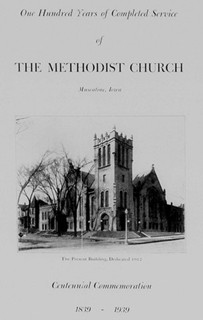 | ONE HUNDRED YEARS OF COMPLETED SERVICE
OF
THE METHODIST CHURCH
MUSCATINE, IOWA
Centennial Commemoration
1839-1939 |
Image 654

LeRoy Louis Weis |
CENTENNIAL WEEK
EVENTS
Sunday, May 14
9:30 a.m. - the Church School
Honoring the Past Superintendents.
10:45 a.m. - The Moring Worship
Service Serman by Dr. L. M. Grigsby, Denison, Iowa. Pastor from 1910 to 1914.
Music by the Chorus Choir, Mr. H.D. Hoyt, Director.
Offertory Solo by Miss Thelma Kintzle.
7:30 p.m. - The Evening Praise Service
Sermon by Dr. John Potter, Pastor from 1904 to 1906.
Music by the Chorus Choir, Mr. H.D. Hoyt, Director. |
| |
| Monday, May 15 - 7:45 p.m. |
| Dedicated to the Memories of Olden Days, Brave Men and Women. |
| Greetings, Recognitions, Felicitations. Short Talks by former Ministers. |
| Music by the Church School Orchestra and Methodist Men's Quartet. |
| Marimba Solo by Mrs. Ruth Springborn Seidler. |
| Informal Reception in the banquet rooms of the Church. |
| |
| Wednesday, May 17 -6:30 p.m. |
| Dedicated to Youth and the Prospective Days of the Second Century. |
| Banquet for all the Young People oof All Church Groups. |
| Dr. Samue W. Irwin, late of Albania, the speaker. |
| Music by the Codette Trio, and The Cornell College Quartet. |
| Miss Ruth Hazlett, Toastmaster. |
| Short talks by Mildred Englund, John Thomas, and William Maeglin. |
| |
| Thursday, May 18 - 7:45 p.m. |
| Community Night and Muscatine County Methodism. |
| Popular Lecture by Dr. Merton S. Rice of Detroit. |
| Music by the High School Chorus, Mr. C. V. Thomas, Director. |
| |
| Sunday, May 21 |
| 9:30 a.m. - The Church School. |
| 10:30 a.m. - The Morning Worship. Serman by Bishop J. Ralph Magee. |
| Music by the Chorus Choir, Mr. H. D. Hoyt, Director. |
| Offertory Solow by Miss Helen Howe. |
7:30 p.m. - Sacred Concert by the Iowa Wesleyan college Choir,
Prof. Samuel C. Ham, Director |
| Address by Dr. Stanley B. Niles, President of Iowa Wesleyan. |
| |
According to an early history written by A. F. Demorest, Reverend Brace preached his first sermon in a small building just enclosed, without floor or plaster, loose board were laid across the sleepers. The first place of regular worship was a small frame building, twenty by forty feet, use also for political meetings, conventions, lyceums, spelling bees and church festivals. This building was located on Iowa Avenue about where the Red Paint Store now stands. It was used until the first Church was built in 1851.

The First Church Building 1851-1869 |
A BRIEF CHURCH HISTORY
IN THE SPRING OF 1839 the Reverend Brace was sent by the Rock River Conference to a mission which included Bloomington, now Muscatine, Iowa. The place, at that time, included about a hundred inhabitants and among them a few professors of the Christian religion. The greater number appeared to "fear not God neither regard man." The first class of members (see below*), seven in all, was formed and began the organized work of the Methodist Church in July, 1839. A Union Sunday School was begun in the same year, the Baptists, Congregationalists, Methodists and Presbyterians co-operating. It was not until 1844 that the Methodist people began their own Sunday School. Joseph Williams, Judge of the District Court, was the first Superintendent. During the century of organized work the people called Methodist have regularly worshiped in four different structures. Worship was first regularly scheduled in a frame building used for public gatherings located on Iowa Avenue between Second and Third Streets. The first Church built was at the corner of Sycamore and Third Streets, afterward used as the city hall. It was built in 1851 and was in use as a house of worship for eighteen years. The second structure was erected in 1869 at the corner of Iowa Avenue and Third Street and was the home of Methodist work and worship for forty-one years. The third and present building is the Church at Iowa Avenue and Fourth Street. The parsonage stands beside it on Fourth Street. It was dedicated in 1912 absolutely free of debt. The Methodist Church in its first century had the leadership of thirty-nine pastors (see below**). Many of them, in the earlier days, served but one year. Two of the pastors served two different terms and another three. A conference rule was the chief reason for short pastorates. In September of 1933 the Cedar Street German Methodist Church merged with First Methodist Church and, since that time, have worked and worshiped together. First Church, Muscatine, has since its beginning belonged to the Iowa Conference until September of 1932 when the Iowa Conference was merged with the Des Moines Conference forming the Iowa-Des Moines Annual Conference. The present pastor is LeRoy Louis Weis the District Superintendent, Dr. Guy J. Fansher, Mt. Pleasant, Iowa and the Bishop, J. Ralph Magee of Des Moines, Iowa.
Image 655 - Repeat of Image 634 with list of Charter Members of the First Methodist Church, Muscatine, Iowa and Pastors of the First Methodist church, Muscatine, Iowa.
Image 656
Muscatine Journal and News-Tribune, Monday, July 30, 1928
OLD CITY HALL BUILDING HAD
LONG RECORD OF PUBLIC USE;
DEDICATED IN 1851 AS CHURCH
Dating back in origin almost past the memory of Muscatine's oldest citizens, Muscatine's first city hall, now being razed to make way for the new administrative offices of the municipal water and light trustees, was originally built as a home for the First Methodist Episcopal church.
Nearly four score years of public service is the record of the building, whose walls might chronicle an interesting tale of local history were they gifted with the power of speech.
Interesting bits of history connected with the venerable building have been gleaned from the county history editions of 1879 and 1911, and from the files of the Journal.
Events leading to the erection of the structure are related in the county history as follows: "At the annual conference in 1845, the first board of trustees of the Methodist church was appointed, the members being Joseph Williams, George Baumgardner, John Lilly, T. S. Batelle, T. Morford, G. Earle, J. A. Parvin, Z. Washburn and S. C. Hastings.
Dedicated in 1851.
"G. B. Bowman was presiding elder and David Worthington the local preacher. The board of trustees at this time launched a movement for a church, the congregation at this time having no edifice of its own. The movement was carried to a successful conclusion and the little congregation built as its place of worship the structure that is now occupied as the city hall. The church was built in 1851 and dedicated Aug. 15 of the same year. The building proved a model at that early day, few, when it was dedicated, anticipating that in less than 20 years the membership would outgrow its quarters and thus make another structure imperative."
Dedication services for the building are reviewed in the Muscatine Journal of Saturday, Aug. 23, 1851, the Journal at that time being a weekly publication. The article follows:
"THE NEW METHODIST CHURCH."
This edifice was dedicated on Sunday morning last, and an able sermon was preached by Bishop Waugh of New York. After the service was concluded, a collection was taken up towards liquidating the debt on the church. About $600 was collected and subscribed.
Largest Church in City.
"This church is the largest in the city, being 65 feet in length by 45 in width, with a spacious gallery; the whole capable of seating comfortably near 600 persons. Besides this, there is an apartment below of the same dimensions, a part of which is to be constructed into a Sabbath school room and the remnant into class rooms.
"The Rev. H. C. Dean is the appointed pastor for the ensuing year." Regarding the Reverend Mr. Dean, the September, 1924, Palimpsest, Iowa State Historical society publication, says, "Born of middle class parents in Fayette county, Penn., Oct. 27, 1822, Henry Clay Dean became one of the historical characters of early Iowa. During his early years in lowa he moved from place to place a typical Methodist clergyman living for a time in Keosauqua, Muscatine, Middletown, West Point and finally in Mount Pleasant, where he resided intil 1871, when he left the state.
"As a minister, he appears to have been of the evangelistic type. Because of his oratorical ability, and particularly his influence with a jury, he was frequently employed by the defense on some of the important capital cases of the Middle West."
City Buys Building.
Another item of interest, affecting the history of the building is contained in the Muscatine Journal of May 30, 1869, a daily paper at that time. "The Methodist church building was densely crowded this afternoon on the occasion of the services accompanying the laying of the corner stone of the new church building.
The new building for the church was dedicated Aug. 29, 1869, and the history of the structure now being demolished is somewhat obscure for the following eight years.
Seemingly it passed into the hands of the German Presbyterian church in the interval, for an item in the Journal of Saturday, May 13, 1876, tells of its purchase from that organization for use as a city hall.
The article follows:
"IMPORTANT PURCHASE BY THE CITY.
The city council today concluded the purchase of the old Methodist church building, corner of Sycamore and Third streets, for $2,500. The property belonged to the German Presbyterian church.
"It is the intention to remodel the building and use it for a city hall, engine house, etc., for which as regards location and room it is admirably located. The Journal has all along advocated the wisdom of this investment, believing that the city hall should be removed from the noise and confusion of the main street, that the city should have a building of its own, and that the property in question was well suited for the purpose and could be had at a bargain."
J. P. Ament was mayor of the city of Muscatine at that time.
New Hall Voted in 1914.
For nearly 40 years, the structure sufficed to met the city's needs for a city hall, but in 1914, $90,000 in bonds were voted for a new city hall, to be built Haymarket square. The contract was awarded July 8, the same year and ground broken for the present city hall a week later.
Since the dedication of the present city hall, the abandoned building has been in use for a variety of purposes, housing equipment of the street commissioner, sufficing as an office for the city food inspector and as a meeting place for Boy Scout troops.
As the work of wrecking proceeds, evidences that building materials and practices were different three fourths of a century ago are apparent. Rough hewn beams of massive proportions supported the roof of the building, and the first layer of sheeting on the rafters was of slabs, indicating that finished lumber may have been more difficult to secure at that time than later, when the sawmill industry flourished in Muscatine.
Bars on several of the windows also indicate that the structure may at some time in its history, have served as a house of detention as well as of worship.
~*~ ~*~ ~*~ ~*~ ~*~ ~*~ |